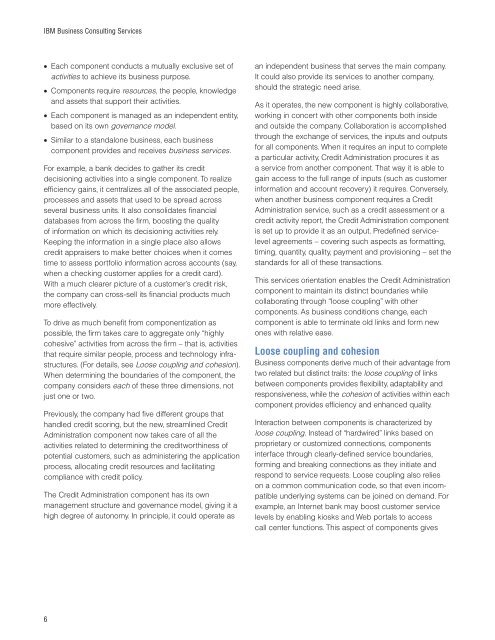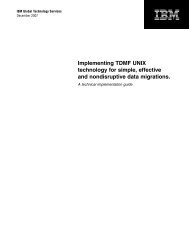Component business models - IBM
Component business models - IBM
Component business models - IBM
Create successful ePaper yourself
Turn your PDF publications into a flip-book with our unique Google optimized e-Paper software.
<strong>IBM</strong> Business Consulting Services<br />
• Each component conducts a mutually exclusive set of<br />
activities to achieve its <strong>business</strong> purpose.<br />
• <strong>Component</strong>s require resources, the people, knowledge<br />
and assets that support their activities.<br />
• Each component is managed as an independent entity,<br />
based on its own governance model.<br />
• Similar to a standalone <strong>business</strong>, each <strong>business</strong><br />
component provides and receives <strong>business</strong> services.<br />
For example, a bank decides to gather its credit<br />
decisioning activities into a single component. To realize<br />
efficiency gains, it centralizes all of the associated people,<br />
processes and assets that used to be spread across<br />
several <strong>business</strong> units. It also consolidates financial<br />
databases from across the firm, boosting the quality<br />
of information on which its decisioning activities rely.<br />
Keeping the information in a single place also allows<br />
credit appraisers to make better choices when it comes<br />
time to assess portfolio information across accounts (say,<br />
when a checking customer applies for a credit card).<br />
With a much clearer picture of a customer’s credit risk,<br />
the company can cross-sell its financial products much<br />
more effectively.<br />
To drive as much benefit from componentization as<br />
possible, the firm takes care to aggregate only “highly<br />
cohesive” activities from across the firm – that is, activities<br />
that require similar people, process and technology infrastructures.<br />
(For details, see Loose coupling and cohesion).<br />
When determining the boundaries of the component, the<br />
company considers each of these three dimensions, not<br />
just one or two.<br />
Previously, the company had five different groups that<br />
handled credit scoring, but the new, streamlined Credit<br />
Administration component now takes care of all the<br />
activities related to determining the creditworthiness of<br />
potential customers, such as administering the application<br />
process, allocating credit resources and facilitating<br />
compliance with credit policy.<br />
The Credit Administration component has its own<br />
management structure and governance model, giving it a<br />
high degree of autonomy. In principle, it could operate as<br />
6<br />
an independent <strong>business</strong> that serves the main company.<br />
It could also provide its services to another company,<br />
should the strategic need arise.<br />
As it operates, the new component is highly collaborative,<br />
working in concert with other components both inside<br />
and outside the company. Collaboration is accomplished<br />
through the exchange of services, the inputs and outputs<br />
for all components. When it requires an input to complete<br />
a particular activity, Credit Administration procures it as<br />
a service from another component. That way it is able to<br />
gain access to the full range of inputs (such as customer<br />
information and account recovery) it requires. Conversely,<br />
when another <strong>business</strong> component requires a Credit<br />
Administration service, such as a credit assessment or a<br />
credit activity report, the Credit Administration component<br />
is set up to provide it as an output. Predefined servicelevel<br />
agreements – covering such aspects as formatting,<br />
timing, quantity, quality, payment and provisioning – set the<br />
standards for all of these transactions.<br />
This services orientation enables the Credit Administration<br />
component to maintain its distinct boundaries while<br />
collaborating through “loose coupling” with other<br />
components. As <strong>business</strong> conditions change, each<br />
component is able to terminate old links and form new<br />
ones with relative ease.<br />
Loose coupling and cohesion<br />
Business components derive much of their advantage from<br />
two related but distinct traits: the loose coupling of links<br />
between components provides flexibility, adaptability and<br />
responsiveness, while the cohesion of activities within each<br />
component provides efficiency and enhanced quality.<br />
Interaction between components is characterized by<br />
loose coupling. Instead of “hardwired” links based on<br />
proprietary or customized connections, components<br />
interface through clearly-defined service boundaries,<br />
forming and breaking connections as they initiate and<br />
respond to service requests. Loose coupling also relies<br />
on a common communication code, so that even incompatible<br />
underlying systems can be joined on demand. For<br />
example, an Internet bank may boost customer service<br />
levels by enabling kiosks and Web portals to access<br />
call center functions. This aspect of components gives

















